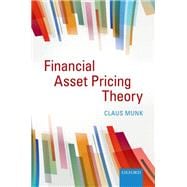Financial Asset Pricing Theory

Financial Asset Pricing Theory
- ISBN 13:
9780199585496
- ISBN 10:
0199585490
- Format: Hardcover
- Copyright: 06/10/2013
- Publisher: Oxford University Press
Rent
Sorry, this item is currently unavailable on Knetbooks.com
Note: Supplemental materials are not guaranteed with Rental or Used book purchases.
Extend or Purchase Your Rental at Any Time
Need to keep your rental past your due date? At any time before your due date you can extend or purchase your rental through your account.
Summary
Financial Asset Pricing Theory offers a comprehensive overview of the classic and the current research in theoretical asset pricing. Asset pricing is developed around the concept of a state-price deflator which relates the price of any asset to its future (risky) dividends and thus incorporates how to adjust for both time and risk in asset valuation. The willingness of any utility-maximizing investor to shift consumption over time defines a state-price deflator which provides a link between optimal consumption and asset prices that leads to the Consumption-based Capital Asset Pricing Model (CCAPM). A simple version of the CCAPM cannot explain various stylized asset pricing facts, but these asset pricing 'puzzles' can be resolved by a number of recent extensions involving habit formation, recursive utility, multiple consumption goods, and long-run consumption risks. Other valuation techniques and modelling approaches (such as factor models, term structure models, risk-neutral valuation, and option pricing models) are explained and related to state-price deflators.
The book will serve as a textbook for an advanced course in theoretical financial economics in a PhD or a quantitative Master of Science program. It will also be a useful reference book for researchers and finance professionals. The presentation in the book balances formal mathematical modelling and economic intuition and understanding. Both discrete-time and continuous-time models are covered. The necessary concepts and techniques concerning stochastic processes are carefully explained in a separate chapter so that only limited previous exposure to dynamic finance models is required.
The book will serve as a textbook for an advanced course in theoretical financial economics in a PhD or a quantitative Master of Science program. It will also be a useful reference book for researchers and finance professionals. The presentation in the book balances formal mathematical modelling and economic intuition and understanding. Both discrete-time and continuous-time models are covered. The necessary concepts and techniques concerning stochastic processes are carefully explained in a separate chapter so that only limited previous exposure to dynamic finance models is required.








